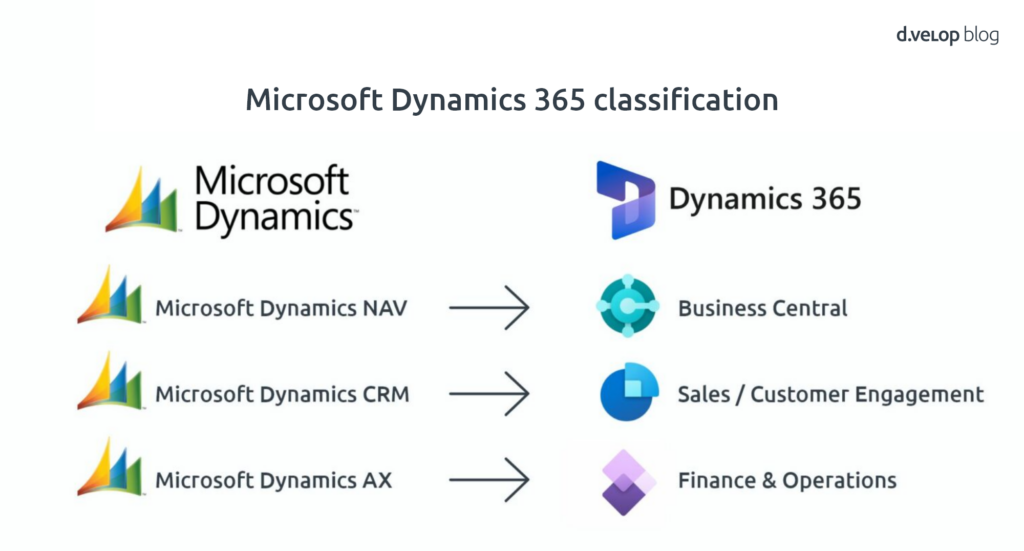Over recent years, Microsoft has shaped the ERP and CRM landscape through acquisitions and its own development. It’s time we took a closer look at the different versions of Microsoft Dynamics.
The most common business applications include customer relationship management (CRM), enterprise resource planning (ERP), supply chain management (SCM) and other modules. These variants cover a wide range of areas and tasks in a company. Special industry solutions are also offered as extensions.

From Microsoft Dynamics AX to Microsoft Dynamics 365
AX (Axapta) is an earlier version of Microsoft Dynamics 365 that was developed specifically for ERP requirements. It offers capabilities for financial management, procurement and supply chain, manufacturing, retail, sales and marketing, human resources management, and more. Dynamics AX was particularly suitable for medium-sized and large companies.
With the successor Microsoft Dynamics 365, Microsoft is consistently pursuing the conversion to a cloud platform. It includes a number of cloud-based applications that support various business functions. Microsoft Dynamics 365 includes modules for CRM, ERP, customer service, sales, marketing, finance, project management and more. It offers an integrated cloud platform that helps companies optimise their processes and manage business data effectively. Microsoft Dynamics 365 in the form of finance, operations or supply chain management is aimed more at large companies. The Business Central solution is more suitable for smaller companies – more on this in the section after next.
Upgrade from Dynamics CRM to Dynamics Sales / Customer Engagement
Microsoft Dynamics CRM was an earlier version of Dynamics specifically aimed at customer relationship management (CRM). It helped companies manage customer relationships, sales, customer service, marketing and analytics. Just like AX ERP, Dynamics CRM was also intended for on-prem operation. At that time, the cloud operating form was not feasible.
In fall 2016, Microsoft Dynamics CRM was replaced by its successor, Dynamics 365 Sales. With the introduction of Microsoft Dynamics 365, the CRM functions were integrated into the Dynamics 365 Sales / Customer Engagement application. Microsoft’s strategy towards the cloud and business apps platform was apparent for their ongoing business model. This means that many apps have been developed for different business areas on the sales stack. These include CRM / Sales, Customer Service, Marketing, Project Management, Retail, Field Service and Talent as an HR module. These functional apps can also be used individually or combined to form a complete solution. This platform approach (based on the Microsoft Power Platform) means there are no longer any piecemeal issues and the business processes are mapped holistically.
Microsoft Dynamics NAV and Business Central – the solution for SMEs
Microsoft Dynamics NAV was an earlier version of Dynamics and emerged from the acquisition of NAVISION Software. The software was also developed for enterprise resource planning (ERP). Dynamics NAV combined many functions for financial management, sales, purchasing, warehousing, production and more. The solution was particularly suitable for small and medium-sized enterprises (SMEs). With the introduction of Dynamics 365, Microsoft Dynamics NAV was renamed Dynamics 365 Business Central from 2018.
Business Central is currently available in the cloud and on-premises. The individual functions are bundled or encapsulated in a system, unlike Dynamics 365 Sales / Customer Engagement and Finance and Operations where individual modules are used. Instead, there are many industry solutions available on the market for a wide variety of application areas. These specific solutions are adapted so that your typical requirements do not have to be developed at great expense, but rather complement the standard.
How is it possible to connect the d.velop platform with Microsoft Dynamics 365?
After the overview of the Microsoft Dynamics solutions, the question arises, how can the ERP and CRM solutions be integrated? How complex is it to use known d.velop solutions in the context of DMS / ECM?
To make it easy for our customers with a Microsoft strategy, d.velop has developed a generic interface and combined it with the d.velop platform . This makes it possible to connect all Dynamics systems with the d.velop platform in order to connect master and transaction data and any documents with the d.velop DMS / ECM.
